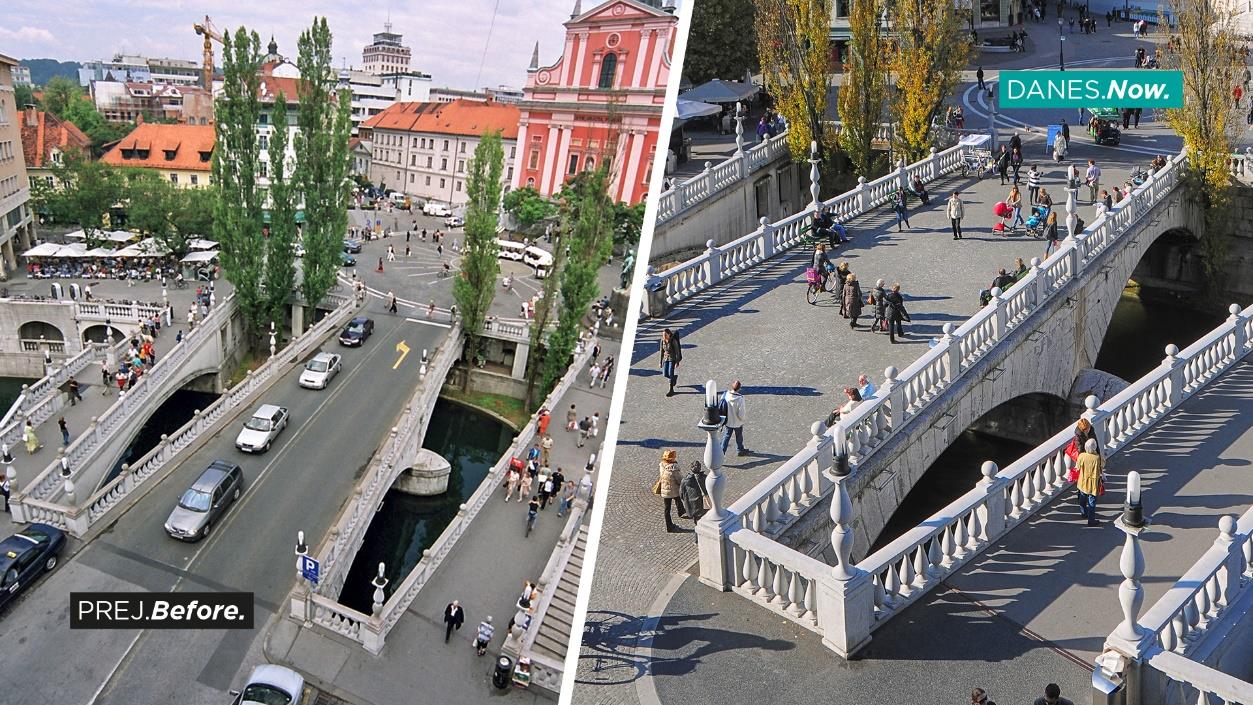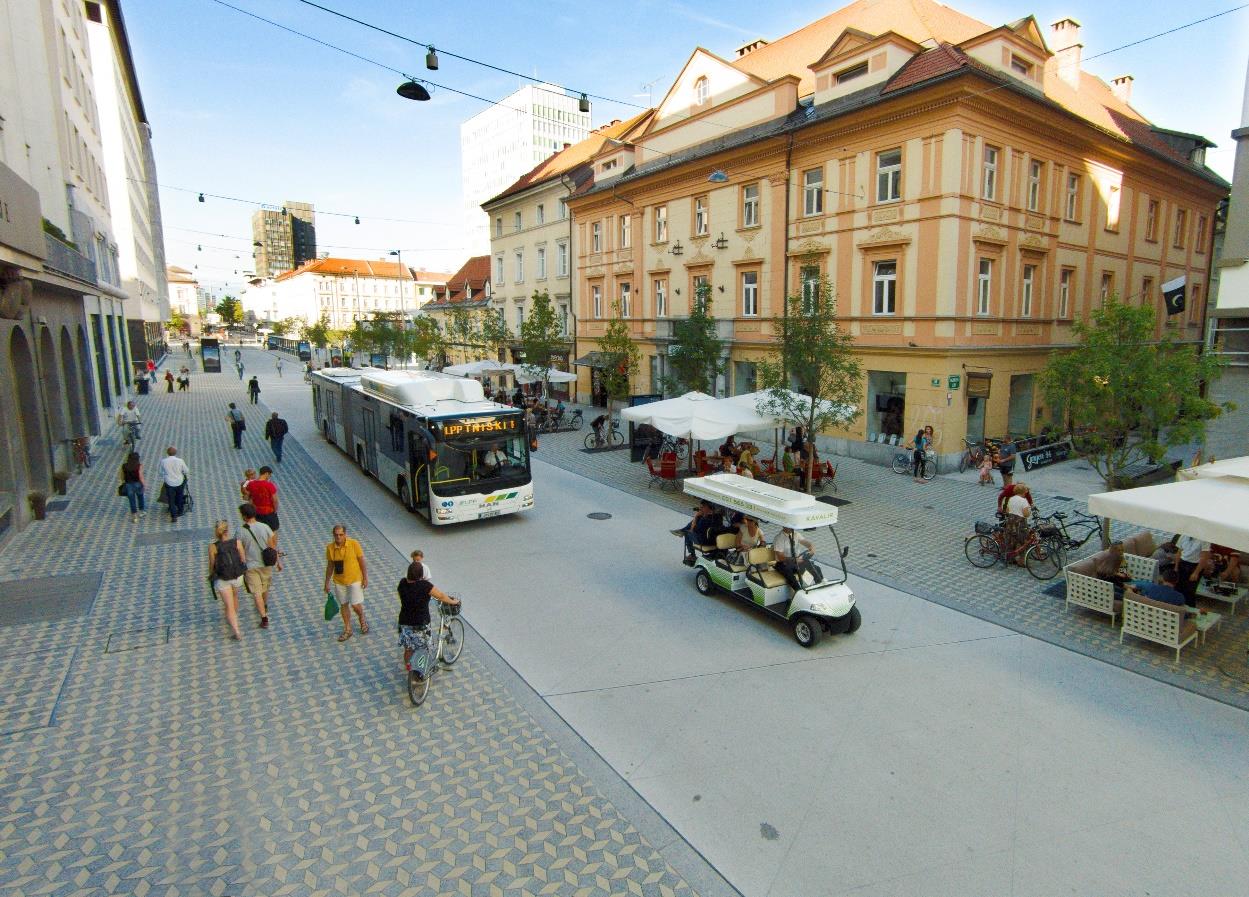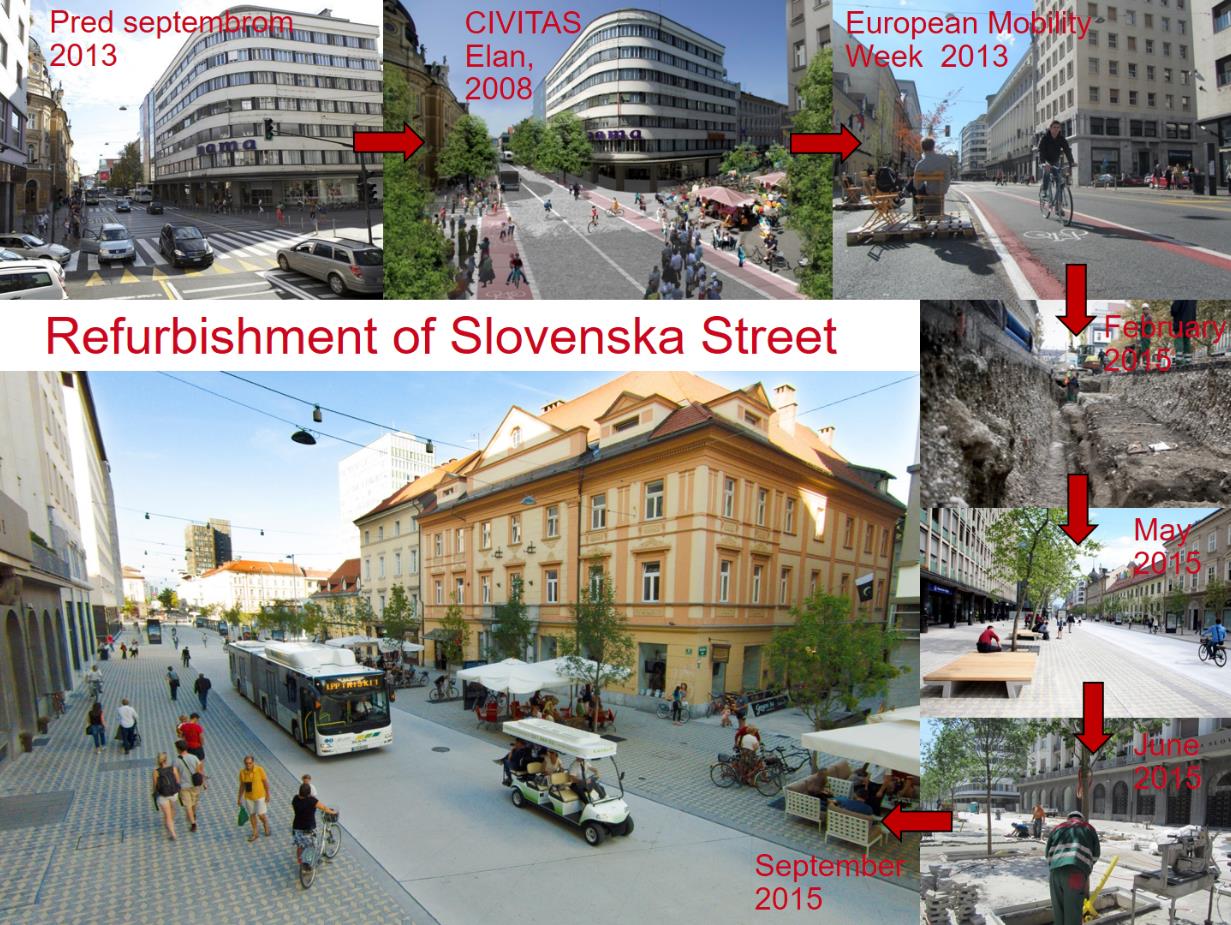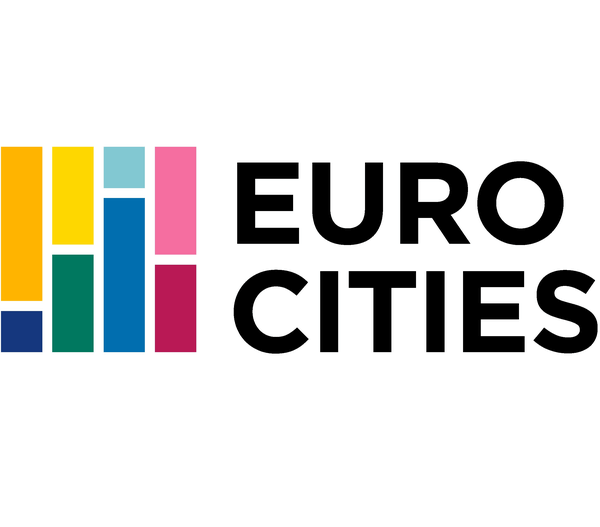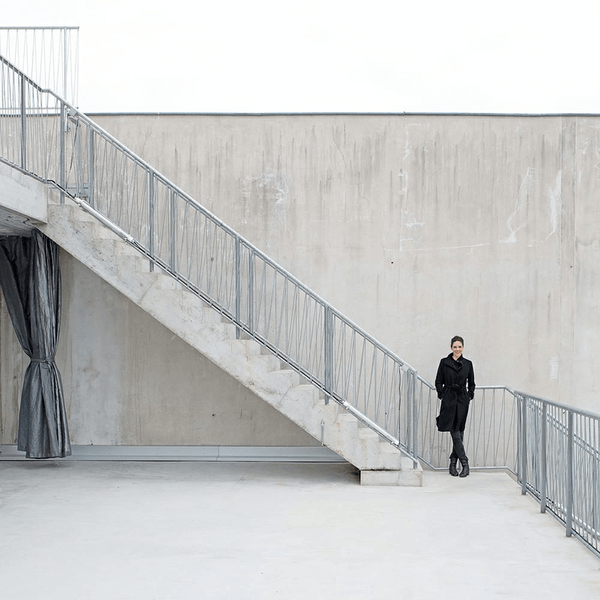City
Ljubljana
Main actors
Local Government
Project area
Neighborhood or district
Duration
Ongoing since 2012
An inclusive approach to urban renewal
Slovenska cesta, once the main transit road for motor vehicle traffic through the city centre, has become an "urban living room" thanks to an inclusive and innovative approach.
In September 2013, the city temporarily restricted private motor vehicles’ access to Slovenska cesta’s central part. In response to residents’ positive feedback to the change, municipality officials permanently turned this area into a public space for pedestrians, cyclists, public transport users, people with disabilities, the elderly and children. The halt to car traffic brought a significant improvement to the area’s air quality, which further strengthened locals’ support for the measure.
Originally published by EUROCITIES, the network of 130 European cities: Link
Eurocities Awards
This project was shortlisted for the 'Eurocities Awards' in 2021 in the following category: Planning public spaces.
The conceptual designs for the Slovenska cesta project were created as a part of the CIVITAS ELAN initiative, which ran from 2008- 2012. During this time, the municipality presented several solutions at different public events and polled residents about their opinions on the project. Meanwhile, an extensive marketing campaign by the municipality and its partners increased public awareness.
In September 2012, the Ljubljana city council adopted a new transport policy that included measures and initiatives on sustainable mobility. One of the main projects envisioned the transformation of Slovenska cesta into a quality public space.
Guidelines for the implementation of a permanent arrangement for Slovenska cesta were prepared in 2013. The coordination among stakeholders was particularly demanding and lasted for over two and a half years. During this time, all elements of the project were carefully examined, from the selection of the tree species and planting methods to urban equipment, paving, bus stops and lightning.
In 2017, the updated implementation plan became part of Ljubljana’s sustainable urban mobility plan.
Project Objectives:
- Improve the quality of public areas;
- Offer a space that encourages people to enjoy the area and stay longer;
- Reduce the number of private motor vehicles in the area;
- Increase the number of pedestrians, cyclists and users of public space and improve their conditions;
- Improve accessibility, especially for people with disabilities, the elderly and children;
- Improve traffic safety in the area;
- Improve air quality and reduce noise in the area;
- Engage with as many stakeholder groups, residents, community groups and experts as possible in the planning and evaluation stages;
- Determine user satisfaction with the new regulation and gain public support.
Since 2007, areas in the inner city of Ljubljana (about 12 ha in size) were converted into quality, multi-purpose public spaces. They are primarily intended for pedestrians with limited motor vehicle access. Cyclists can also use these areas while six smaller on-demand electric vehicles are available for free. The area now offers better space for social activities, culture, sports and entertainment events, and shopping thanks to the stop to motor traffic, street renovations, bridges, landscaping and revitalization of the river embankments.
The municipality has renovated the surface of all communal infrastructure and underground cable installations. The refurbished area now offers increased opportunities for economic development (shops, bars, shopping, cafes); boasts 63 new trees, air quality measurements, new urban equipment (benches, seating islands, lighting, water elements, special pavers, curbs, tactile paths, bicycle stands, bus stops with real-time information) that offer people an enjoyable stay.
As Slovenska cesta is located in a central area of the city, changes to car circulation here affected traffic elsewhere in the city. The municipality introduced new sustainable mobility measures to help locals avoid driving to the city: it created yellow lanes for buses on the surrounding access roads (priority for public passenger transport); it upgraded its fleet with non-polluting buses; it optimised routes and adjusted traffic light intervals
City officials also added parking lots on the outskirts of the city, created park and ride system, and expanded the Bicikelj bicycle-sharing scheme. Ljubljana continues to make improvements to its cycling infrastructure and pedestrian areas. It also launched an electric car- sharing system.
In addition to the renovation of the central part of Slovenska cesta, the northern and southern parts of Slovenska cesta and surrounding roads and streets were also refurbished.
The implementation of construction works for the comprehensive renovation of the central part of Slovenska cesta amounted to approximately 3 million EUR. In addition to this, the costs of the temporary arrangement for Slovenska cesta amounted to approximately 20,000 EUR.
Reduction of motor vehicle traffic
According to data from the automatic traffic meter, the average vehicle flow in the central part of Slovenska cesta was around 21,000 vehicles per day in both directions, of which around 1,600 were buses. Data also show that the average daily traffic numbers at the four measuring locations has significantly decreased compared with 2013.
More pedestrians, cyclists and public transport users
Based on field observations, the number of pedestrians and cyclists in the central part of Slovenska cesta has significantly increased. The refurbished area offers a more convenient space for users, replacing narrow sidewalks without bike lanes and a four-lane road with heavy traffic. The new public passenger transport stations and services also encourage the use of public buses. The new traffic regime on Slovenska cesta has led to an increase in the number of passengers and faster bus travel, The travel time of buses has improved by 3 to 5 minutes after the introduction of the bus-only yellow lanes. The changed traffic regime had an impact on the increase in the number of the passengers - within one week of the introduction of the change, the number of users increased by 60,000.
Better accessibility
Since the area is built in a nearly straight horizontal plane, there are no height barriers at the location that would cause problems for people with disabilities. In the area around the bus stops there is also tactile paving for people with visual impairments, and the bus stops are equipped with Braille inscriptions on the canopies. Disability organization representatives on several occasions praised these accessibility improvements.
Improved traffic safety
In the initial phase, the municipality gave warnings for traffic violations and distributed information leaflets to raise awareness among motor vehicle drivers. A few weeks after the enforcement of the new traffic regulations, the violations became less frequent. According to local police data, safety in the area has improved. Before the renovation, the speed limit was 50 km/h, but after the renovation it decreased. Buses now drive at around 10 km/h. A stationary automatic measuring device was installed in 2017 on the central part of Slovenska cesta. In 2018, there were 593-recorded speeding offenses; in 2019, that number decreased to 182, in 2020 to 138. New public lighting in the area has been installed and additional floor lights indicating where pedestrians most frequently cross the street.
Better air quality and noise reduction
Black carbon is the most suitable measure for monitoring the local pollution effects of exhausts from combustion processes, heating systems, industry or internal combustion vehicle engines. A black carbon research was carried out in August 2013 at three locations, including Slovenska cesta, which was still open to all traffic at that time. In September 2013, the city repeated the measurements when a section of Slovenska cesta was already closed to private vehicles but busses could still circulate. Results showed that the share of black carbon in the air had decreased by 70% due to the closure of the traffic for personal vehicles, while it did not decrease on the surrounding streets. Private vehicle traffic has the significant impact on local air pollution in the city centre, and the air quality has dramatically improved with the ban on private vehicles. Noise in the area was reduced by 6dB.
More about the research: https://www.sciencedirect.com/science/article/pii/S135223101530100X
Increased public support
The project enjoys great public support, as confirmed by the statics below.
Survey on citizen satisfaction of the City of Ljubljana (June 2018; n = 750; Ninamedia)
For the surveyed Ljubljana residents, the most important initiatives in the City of Ljubljana (out of 24 possible answers) are the following: the arrangement and renovation of the City of Ljubljana (25.9%); the traffic arrangement in the city centre (23.1%); the arrangement of the Ljubljanica embankment (19%); the renovated Slovenska cesta (18.2%) and the Bicikelj project (17.8%).
Fifteen major projects implemented in the last decade were included in the survey. Respondents were asked to indicate whether they support the implementation of a specific measure. The Bicikelj rental system and the introduction of a pedestrian zone in the city centre received the greatest support (94%). The closure of Slovenska cesta to private vehicle traffic received an 88% approval among those polled.
Mobility Survey (February 2017; n = 1000; Ninamedia):
A third of respondents cited the renovated Slovenska cesta as the biggest change in Ljubljana’s traffic; a tenth pointed to the pedestrian area.
The CIVITAS ELAN survey, European Mobility Week (September 2009, n = 558; City of Ljubljana)
94.6% of respondents supported the closing of the central part of Slovenska cesta to private vehicles.
Info point on Slovenska cesta (September - December 2013)
Finding the right traffic arrangements posed considerable challenges. Based on expert findings, it was decided to put a 30 km/h speed limit in the central area of Slovenska cesta.
Based on similar experiences from other cities such as Vienna, city officials expected grievances from motorists following the changes. However, they did not significantly materialise.
Like in any large-scale project, it takes time for the public to adapt to urban changes. This was the case when the city centre was declared off-limits to private vehicles. People initially filed many complaints, but the situation changed; now, there are nearly none.
Governments, local leaders, urbanists, developers and residents are increasingly identifying public space as one of the most important elements to shape a city’s character. City centres bring together different segments of the community, and public spaces should be available to programs activities that are important to users.
The different ways of using streets, squares and promenades can create a memorable experience for residents and visitors. The central part of Slovenska cesta was designed with this in mind, and has become a place for people to meet, socialise, shop, sit or simply walk.
The project is in line with the global trend to divert car traffic in city centre roads and make central areas more communal, friendly urban environments. Examples include Vienna’s Mariahilferstrasse; Copenhagen’s Norrebrogade; London’s Exhibition Road; New York’s Times Square; San Francisco’s Market Street; Sydney’s George Street; Melbourne’s city centre streets.
External links / documents
On Map
The Map will be displayed after accepting cookie policy

